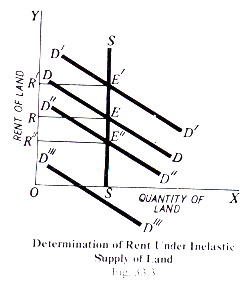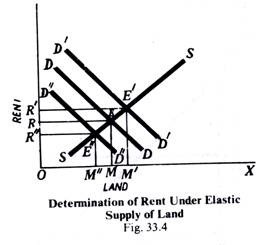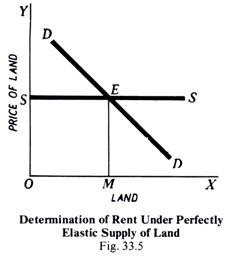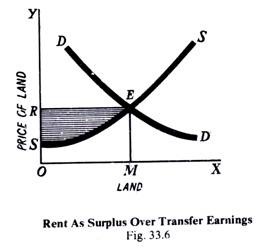Modern theory of rent does not confine itself to the reward of only land as a factor of production.
Rent in modern sense can arise in respect of any factor of production, and not merely land. Rent is a surplus. In the sense of surplus, rent is a payment in excess of transfer earnings.
Transfer earnings mean the amount of money which any particular unit could earn in its next best alternative use. Suppose a piece of land under cotton is yielding Rs. 150 and its next best use wheat fetches Rs. 100. The transfer earnings are Rs. 100 and, therefore, in its present use it is giving a surplus of Rs. 50.
We can also define transfer earnings as the minimum sum which must be paid for a unit of a factor of production in order to induce it to staty in its present use or employment. In the above example, a sum of Rs. 100 at least must be paid for the land under cotton in order to retain it under cotton; otherwise it will shift to wheat, which is its next best alternative use where it can fetch Rs. 100. Actually, this piece of land is earning Rs. 150, i.e., Rs. 50 extra or in excess of its transfer earnings. This is economic rent. Economic rent in this sense is thus the difference between the present earnings and the transfer earnings.
ADVERTISEMENTS:
This concept of rent is applicable not merely to land but also to all factors of production i.e. labour, capital and entrepreneur’s earnings too. They can all earn economic rent in the sense that the modern economists use the term ‘rent’.
How Rent arises:
Rent in the sense of surplus arises when the supply of land, or for that matter that any other factor service, is less than perfectly elastic.
From the point of elasticity of supply, there are three possibilities:
ADVERTISEMENTS:
(a) The supply may be perfectly elastic, which can be shown as a horizontal straight line, as in Fig. 33.5 above.
(b) The supply of land may be absolutely inelastic. This is shown in Fig. 33.3 by a vertical straight line.
ADVERTISEMENTS:
(c) There is the situation in between these two extremes, i.e., it is elastic, but not perfectly elastic. This is shown in Fig. 33.4.
In these three conditions, rent as a surplus over transfer earnings will be different.
If the supply is absolutely inelastic (see Fig. 33.3), the transfer earning is zero, because land cannot be transferred to any use; the supply of land is fixed, and it has only one use, whether it is used or not. In this case, the entire income from land is surplus, and hence rent.
When the supply of land is perfectly elastic, there will be no surplus and the actual earnings and transfer earnings will be equal. For example, for an individual firm or farmer, the supply of land is perfectly elastic.
Suppose the supply is elastic but not perfectly elastic, then a part of income from land is rent (in the sense of surplus over transfer earnings), and a part is not rent.
These three conditions are represented in the diagrams as mentioned below:
In Fig. 33.3, DD is the demand curve and SS a vertical straight line fixed supply curve. They intersect at E. Here OS is the quantity of land used. OR (=SE) is the rent per unit and total earnings are OSER. Since land is fixed in supply and cannot be transferred to any other use, its transfer earnings are zero. Hence its entire earnings OSER are rent as surplus over transfer earnings.
For the economy as a whole, land has no alternative use at all. Hence the transfer earnings of land, from the point of view of economy as a whole, are zero and all the earnings are rent.
ADVERTISEMENTS:
In Fig. 33.5, the supply curve SS of land is a horizontal straight line which is perfectly elastic. DD is the demand curve. The two intersect at E. In this case, OM land is put to use. The rent per unit is OS (=EM) and the total earning is OMES. The transfer earning is also OMES. If this firm does not pay OS rent, the land will be transferred to some other use or firm. Since transfer earnings and actual earnings are equal, there is no surplus or rent.
In Fig. 33.6, SS supply curve is somewhat elastic. It cuts DD demand curve at E. In this case, OM land is used and the rent per unit is OR (= ME). The total earnings are OMER and the transfer earnings are OMES. If we deduct transfer earnings OMES from the actual earnings OMER, we get RES (shaded area). This is surplus or rent.
Surplus in Other Factors Too:
ADVERTISEMENTS:
It should be borne in mind that the above analysis with regard to rent as surplus over transfer earnings is applicable not only to the share of land, but also to the shares of other factors, viz., wages, interest and profits. This applies to all cases where the supply of a factor is less than perfectly elastic. In such cases, a part of present earnings is the transfer earnings and the remainder is economic rent.
Comparison between the Ricardian Theory and the Modern Theory of Rent:
Now that we have studied the two main theories of rent, viz., the Ricardian theory (or the classical theory) and the modern theory of rent, we should be in a position to distinguish between the two. We can see that both theories regard rent as a surplus.
In Ricardo’s theory, the surplus is due to superiority (or natural differential advantage) of the land in question over the marginal one. The superiority may be due to either quality of the land or better situation. Also both theories of rent have the same concept of land, i.e. a natural factor rather than a man-made factor like capital, but then where is the difference between the two theories.
ADVERTISEMENTS:
The difference between two is basic and it lies in this that while Ricardo takes agricultural land (the cultivation of which is subject to the law of diminishing returns sooner or later), the modern economists, on the other hand, do not confine the concept of rent to agricultural land only.
As we have said earlier, rent can arise in the sense of surplus in the case of other factors of production also and even in a situation of increasing returns. Rent represents the opportunity cost or transfer earnings. In this sense, rent is of a more general nature applicable to all factors. That is why it is said. “It (land rent) is leading specie of large genus”. That is, land rent is not a separate class by itself. It is only a prominent example of its type.



